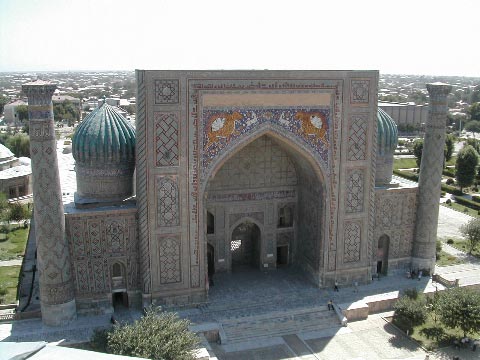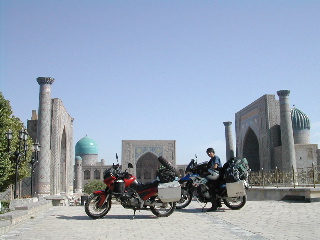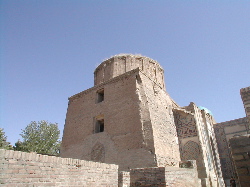| Samarkand/サマルカンド (2003.07.26-2003.07.27)  Having seen all there is to see in Tashkent, we took off for the 2,500 year old city of Samarkand. We encountered a big problem on the road--there is a gas shortage in Uzbekistan. Gas stations were present every few kilometers, but none of them had the 93 octane gas they advertised. Most only had 76 or no gas at all! We contemplated going back to Tashkent for gas, but there was no guarantee we would find good gas there either. So we bought the 76 and drove on to Samarkand where we were fortunate to find decent gas. We were lucky and the low-octane gas didnユt produce any engine knocking or other problems with the bikes. The well-paved road to Samarkand was an easy ride except for the heat. This far south, the temperature rose to 40 degrees Centigrade in the summer. We had to take a break in the shade at least once an hour. The heat we had expected, but there was a surprise waiting for us on the way to Samarkand. About 25 km of the road crosses through Kazakhstan. The road signs told us how far we were from Samarkand, but they didn't mention any detours. So we just plodded on. At one of the numerous police checkpoints, this just a couple hundred meters from the previous, they were strangely interested in our Kazak visas. Chris pointed out that the officer was writing down our Kazakhstan visa numbers, not the ones for Uzbekistan. The officer simply pointed to his uniform insignia and proclaimed to our surprise that they were Kazak border patrol and were now entering Kazakhstan. Thinking that we were about to use our second entry of a double-entry visa, we desperately tried to stop them from signing us into the country. Fortunately, travel on the road only counted as transit through Kazakhstan. They didn't put the second use stamp into our passports, and we would still be free to cross through Kazakhstan again to get back to Russia. Later we heard that travelers used to have to take the long way around, but the regulations have been loosened since then. Our road took us eventually out of the cultivated agricultural area and into the dry hillside. From there we emerged into the Blue City of Samarkand. The monumental mosques of the old city were visible long before we entered the city itself. Two Australian riders who had been through Samarkand a week before us recommended a guest house whose courtyard we could park in. We gave ourselves two days to see the historical monuments of one of the most important cities in the Islamic world. We wandered through the Shahi Zinda ensemble, awed at the blue tiles of the enormous Bibi Khanum mosque, and climbed the minaret at the Registan square. The last involved a bribe to the police officer on guard, but gave us a birds-eye view of the city. Samarkand is a center of silk road culture, and as so, a very tourist-oriented city. Students from the local language institute maintain a tourist information center during their summer vacation. That gives them a chance to practice their language skills and gives tourists a good source for information and assistance in Samarkand. Most speak English and Japanese in addition to Uzbek, Russian and Tajik languages. Some also speak a few European languages. The students became one of the highlights of Samarkand for us. We even stopped by to say hi when we passed through on the way back from our next destination, Bukhara.   タシケントを後にして、2500年の歴史を持つサマルカンドに向かい出発する。ところがこの国ではガソリンが不足しているようだ。数十キロおきにスタンドがあったが、オクタン価93のガソリンが手に入らない。殆どの所ではオクタン価76のものしかなかった。給油のためタシケントに戻る事も検討したが、そこにもガソリンがある保証はないため76のガソリンを入れて走り続けた。幸いノッキングも起こらず、難なくサマルカンドまで進むことができた。(サマルカンドではいいガソリンがあった。) |
| <CentralAsia TOP> <Previous> <Next> |
